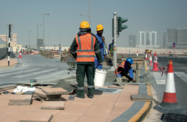Abu Dhabi’s construction sector appears set to return to near-full capacity, with the government announcing it is reactivating a number of major development projects and stepping up spending on infrastructure development.
In late January, the government unveiled its revised construction programme, putting a number of formerly stalled projects on the top of its investment agenda, a move that will revive the spirits of the emirate’s construction sector. Perhaps the highest profile of the revitalised projects are the Abu Dhabi branches of the Louvre and the Guggenheim museums, with the former now scheduled to open in 2015 and the latter two years later. Under the initial plans announced in 2007, the museums, as well as the other institutions that are to make up an arts and culture centre on Abu Dhabi’s Saadiyat Island, were to begin opening their doors this year.
In total, the culture complex was budgeted at around $27bn, though the total cost may be scaled down, as the start dates for some elements of the project may be pushed back further. Additionally, new bids for some elements of the development may be called for, which could see costs reduced in what is now a less-heated construction environment.
The government’s building programme also included a number of big-ticket infrastructure projects, including a new terminal for the Abu Dhabi International Airport; roads and a light rail network; the expansion of maritime facilities; 24 new schools and 14 health centres; the development of the Khalifa Industrial Zone; and the construction of two new industrial zones in the Western Region of the emirate.
The renewed commitment to the development projects was welcomed by the construction industry. Miceal Sammon, the chief executive of Irish construction firm Sammon Group, believes the increasing pace of project development is a reassuring sign for the future.
“For international companies like us, it reaffirms and encourages us to keep the commitment to the UAE,” he said at the end of January.
While the government plans to emphasise infrastructure and high-profile cultural and economic projects, it has made no mention of any new large-scale residential or commercial developments – formerly central pillars of the emirate’s construction industry – with the exception of several large housing developments underway throughout the emirate. This is likely to be a reflection of the reality of the current market, as Abu Dhabi is currently oversupplied with office and residential properties. Weaker demand is pushing rental and sale prices down, a trend that analysts expect to continue throughout 2012.
David Dudley, the regional director of property consultancy Jones Lang LaSalle, said the absence of new housing or office developments in the government’s announcement points to a reduction in future releases of real estate supply.
“Several previously announced, government-backed real estate projects have been excluded from the list, emphasising the government’s ongoing rationalisation of real estate supply to establish more stable market conditions,” he told local media after the revised development plan was unveiled.
A recent report from real estate consultancy CB Richard Ellis said that projects currently in the construction pipeline would maintain the supply-demand imbalance for at least another year.
“Amidst a more positive economic outlook, downside risks still persist with the imminent delivery of a significant volume of new developments, covering both the residential and commercial sectors,” said the report, issued on February 21. “With supply forecast to outstrip demand over the next 12 months, a further drop in rental rates is inevitable.”
The likelihood of weaker returns on rental properties in the near term will serve as a disincentive for private investors to float new construction developments, a situation that will probably continue until the existing glut shows signs of clearing. This oversupply will also see a further fall in housing prices, with many analysts predicting a retreat of 14% or more this year.
However, except for those firms completely dedicated to projects in the housing or office segments, there will be a steady increase in momentum through 2012 and beyond. The benefits from the developments the government intends to focus on should flow through the sector for some years to come.

